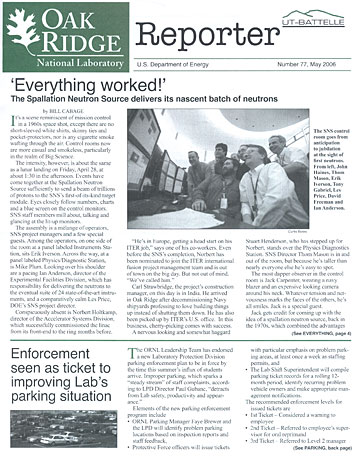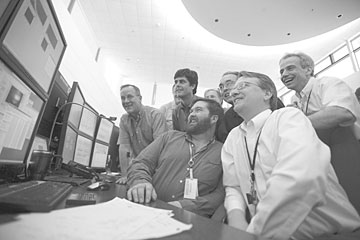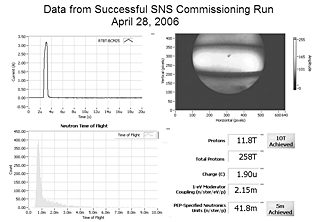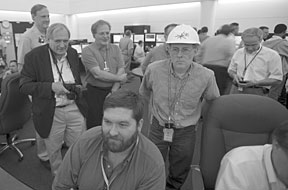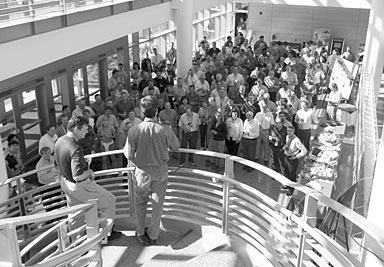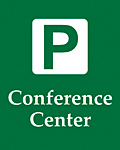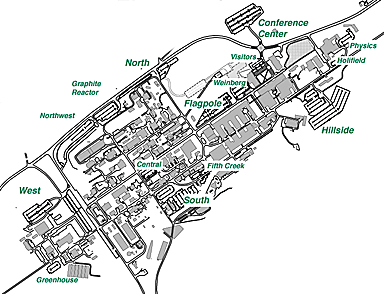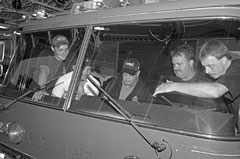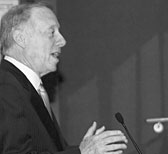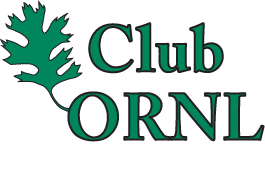 |
Number 77, May 2006
|
The Spallation Neutron Source delivers its nascent batch of neutrons
|
|
| The SNS control room goes from anticipation to jubilation at the sight of first neutrons. From left, John Haines, Thom Mason, Erik Iverson, Tony Gabriel, Les Price, David Freeman and Ian Anderson. |
It’s a scene reminiscent of mission control in a 1960s space shot, except there are no short-sleeved white shirts, skinny ties and pocket-protectors, nor is any cigarette smoke wafting through the air. Control rooms now are more casual and smokeless, particularly in the realm of Big Science.
The intensity, however, is about the same as a lunar landing on Friday, April 28, at about 1:30 in the afternoon. Events have come together at the Spallation Neutron Source sufficiently to send a beam of trillions of protons to the SNS’s first-of-its-kind target module. Eyes closely follow numbers, charts and a blue screen on the control monitors. SNS staff members mill about, talking and glancing at the lit-up monitors.
The assembly is a mélange of operators, SNS project managers and a few special guests. Among the operators, on one side of the room at a panel labeled Instruments Station, sits Erik Iverson. Across the way, at a panel labeled Physics/Diagnostic Station, is Mike Plum. Looking over his shoulder are a pacing Ian Anderson, director of the Experimental Facilities Division, which has responsibility for delivering the neutrons to the eventual suite of 24 state-of-the-art instruments, and a comparatively calm Les Price, DOE’s SNS project director.
Conspicuously absent is Norbert Holtkamp, director of the Accelerator Systems Division, which successfully commissioned the linac from its front-end to the ring months before.
“He’s in Europe, getting a head start on his ITER job,” says one of his co-workers. Even before the SNS’s completion, Norbert has been nominated to join the ITER international fusion project management team and is out of town on the big day. But not out of mind. “We’ve called him.”
|
|
| This instrumentation monitor screen shows when the SNS reached its goal on April 28. The orb at upper right depicts protons striking the target. The reading just below, Protons 11.8T, indicates the target has been hit with nearly 12 trillion protons. They only needed 10 trillion. “This was the pulse that beat that goal!” says Ian Anderson. |
Carl Strawbridge, the project’s construction manager, on this day is in India. He arrived in Oak Ridge after decommissioning Navy shipyards professing to love building things up instead of shutting them down. He has also been picked up by ITER’s U.S. office. In this business, cherry-picking comes with success.
A nervous looking and somewhat haggard Stuart Henderson, who has stepped up for Norbert, stands over the Physics Diagnostics Station. SNS Director Thom Mason is in and out of the room, but because he’s taller than nearly everyone else he’s easy to spot.
The most dapper observer in the control room is Jack Carpenter, wearing a navy blazer and an expensive looking camera around his neck. Whatever tension and nervousness marks the faces of the others, he’s all smiles. Jack is a special guest.
Jack gets credit for coming up with the idea of a spallation neutron source, back in the 1970s, which combined the advantages of a pulsed neutron source with time-of-flight neutron scattering instruments.
He has helped with the SNS project. He’s come to Oak Ridge frequently throughout the project. “I’ve spent about half my
working days dealing with SNS questions,” he says.
Jack recalls the first spallation source was built at Argonne National Laboratory in 1974. It was called ZING-P, for Zero-Intensity Neutron Generator-Pulsed. Now, more than 30 years later, Jack is waiting for the most intense neutron source in the world to go live.
John Gunning, a ZING-P alum, notes that the Argonne machine had shielding made from an old battleship’s steel and a leftover World War II-vintage accelerator from Berkeley Lab.
“We’ve come a long way. I would have never envisioned how far,” Jack says.
|
|
| Jack Carpenter (top photo, left, dark blazer), Tony Gabriel, Erik Iverson, Rick Reidel (hard hat) and Ian Anderson (with PDA) watch readings on the instrumentation panel. (Below) Frank Kornegay, Rob Taylor and Mike Plum monitor progress over at the physics diagnostics station. |
|
|
Some of those in the control room are well into a very long day. April 28 began to look like the big day a couple of weeks before, and SNS staff had been putting in extra hours in the run-up. The project had completed a series of successful commissionings, beginning with Berkeley Lab’s front-end system, then Los Alamos’s warm linac, then Jefferson Lab’s cold (superconducting) linac, and most recently, in February, Brookhaven’s accumulator ring as the SNS team worked its way up to sending protons to the target. Despite the expected bugs and kinks, everything had gone smoothly and better than could have been expected.
The SNS mantra of “on time, on budget, on scope” wasn’t just blowing smoke. The project was putting its money where its mouth was.
Then early Friday morning things began to unravel. One of the magnets that steers the beamline started leaking water. Then one of the niobium cavities in the superconducting linac started misbehaving, as they sometimes do. Problems arose, were addressed and corrected.
But things went from bad to worse: Around mid-morning a 13-kv transformer tripped out, shutting down some moderators and parts of the linac. Doubts arose and despair set in. Some of the control room staff decided to go home for a nap while a team led by operations chief Frank Kornegay set out to troubleshoot the power problem.
Causative factors were speculated: Somewhere in the circuitry probably lay a fried skunk, or possum, or raccoon. The SNS site on Chestnut Ridge, surrounded by woods, is blessed with abundant wildlife. There was even an elk until a myopic deer hunter shot it a few years ago.
By lunch time things were back up and running and people were called back to the control room. Shortly before two o’clock a hard-hatted Rick Reidel is summoned to the Instrument Station to explain something about a reading.
At 2:04, somebody lets out a whoop and the room erupts into applause. The blue screen on the control monitors takes on a goldish smudge, and charts record peaks and valleys.
A few minutes later Thom Mason comes on the SNS public address system, stating that 5.5 x 1010 (or 55 billion) protons have been sent to the target with neutrons to go with them.
“We are now officially a neutron source,” Thom says.
The criterion for the completion milestone, called CD-4, is 1 x 1013, or 10 trillion protons. Nobody’s going home.
After the big moment’s laughing and handshaking the control room buzz dies down. People trickle in and out. John Haines, who led the target team, arrives. He began the project in the late 1990s with Tony Gabriel, who is present in the control room. Tony came to the SNS project from a leading role in the Superconducting Supercollider project, the major science project that never happened.
Over at the diagnostics panel Mike Plum and crew tune the beam. Every once in a while another shot is sent to the target, as Erik yells “ready” across the room and through the spectactors at Mike. The gold smudge on the blue screen, which was off center at first, edges its way toward the middle.
“The actual target is between those lines,” says physicist John Munro, pointing at tic-tac-toe lines on the blue screen.
|
Early Friday, things began to unravel. Somewhere in the circuitry was probably a fried raccoon, or possum, or skunk... |
“Bullseye!” the diagnostic team’s Tom Shea says. The golden smudge is now centered in the crosshairs and very bright.
Duncan Mansfield, a reporter for the Associated Press, is led into the control room. He has been working on an SNS piece for some time and drove to Oak Ridge after being notified the moment had almost arrived. He remarks on the way into the control room, “I tried to make the neutron scattering as clear and simple as I could, and my New York editor calls me back and says, ‘Now what does this thing do?’” Mansfield immediately starts interviewing Thom and taking in explanations of the information on the control panels.
Stuart Henderson and Sarah Cousineau at the diagnostics panel talk about their long day. Sarah went home for a couple of hours’ sleep when the morning problems started to cascade, then was called back in when things looked up.
“I hardly slept at all last night,” Stuart says. “I had dreams about targets. No, not nightmares. These were happy dreams.” In Norbert’s absence, Stuart is an acting manager, after all.
Another shot. “Bring it on.”
The SNS project arose out of the ashes of another dream to re-establish U.S. predominance in neutron science—the Advanced Neutron Source, a research reactor that was to be built at ORNL. Because it was a nuclear reactor—and a wonderful one it would have been—it came with all the perceived problems, including proliferation concerns with its highly enriched uranium fuel and, above all, a steep price tag of $3 billion. With design efforts under way, support for the project waned and Congress cut off funding in 1995.
Shortly thereafter then-ORNL Director Al Trivelpiece called a staff assembly and announced that an accelerator-based source would be built at ORNL instead, called the Spallation Neutron Source. It would cost an acceptable billion dollars or so. Bill Appleton, an associate director and materials researcher, would lead the project, which would involve four other labs.
Five national labs on one design and construction project was a crazy enough idea. Eventually there would be six labs involved.
But Big Science was struggling in the United States and needed a new approach. In addition to the ANS, all that was left of the Superconducting Supercollider was a section of a 50-mile circular tunnel in Texas looking for a purpose. People went to Europe to do neutron analysis. DOE hadn’t built a science facility on this scale in years. Now there was talk about another big neutron project, an accelerator-based source at ORNL, a reactor lab that didn’t have much background in linear accelerators.
“They’ll never build it,” somebody murmured in the back of Wigner Auditorium.
|
|
| Sarah Cousineau got a few hours sleep while the problems were being fixed. |
At 3:30 p.m. the control room breaks out in another roar. There is again lots of back slapping and hand shaking and cheering. The SNS, an hour and a half after producing its first neutrons, has delivered its 1 x 1013 protons to the target. That’s the beam-power mark for completion.
“That looks awfully good. I was afraid you weren’t going to try it,” a grinning Tony Gabriel tells Ian Anderson.
Sarah remarks on the 90-minute span between first neutrons and attaining the beam-power milestone: “Everything worked! This is the fastest commissioning I’ve ever seen. From beam to target to CD-4 in one and one-half hours. Usually it takes weeks.”
|
“We are now officially a neutron source.” |
On the Physics-Diagnostics Station electronic logbook somebody types: “Here is what so many have labored toward for so many years.”
At 5 p.m., SNS staff gather in the lobby of the SNS’s Central Laboratory and Office Building. Thom and Lab Director Jeff Wadsworth stand on a stairwell holding plastic flutes of champagne and lead the gathering in a toast to their success.
“April 28, 2006, will go down in history as one of the greatest days in the history of the Lab,” Jeff says. “I look forward to the science that is to come.”
Someone down on ORNL’s main campus remarks a few days later: “They made it look easy.” 
|
|
| Jeff Wadsworth (stairwell, left) and Thom Mason address SNS staff at the first neutrons victory celebration. |
The ORNL Leadership Team has endorsed a new Laboratory Protection Division parking enforcement plan to be in force by the time this summer’s influx of students arrive. Improper parking, which sparks a “steady stream” of staff complaints, according to LPD Director Paul Gubanc, “detracts from Lab safety, productivity and appearance.”
Elements of the new parking enforcement program include
|
|
Click image for larger view. |
One of the aims of the new parking enforcement campaign was to name the Lab’s parking lots so that people can more easily locate spaces available to them. Now most or all of the Lab’s major parking lots have a name.
Before the effort, few lots had actual names; plenty had nicknames, such as the flagpole lot, stationed near Building 4500-North’s landmark flagpole, and the 6026 lot, named after trailer offices that were removed to make way for the new lot.
Flagpole keeps its name, but naming a parking lot after trailers that aren’t there any more isn’t particularly helpful to those who are new to the Lab. That parking area, one of the Lab’s largest, is now the more geographically intuitive Hillside Parking Lot.
Other names either incorporate already established names, like Flagpole, or reflect something about the location. The map shows the names and locations of the Lab’s major parking lots.—B.C. 
University of Tennessee-ORNL Distinguished Scientist Ward Plummer has been elected to the National Academy of Sciences. He becomes the only UT and ORNL researcher currently in the NAS.
Ward came to ORNL and UT in 1992, joining the then Solid State Division and UT’s Department of Physics and Astronomy. Membership in the NAS is one of the nation’s highest science honors, reflecting a distinguished career and significant research achievements.
Ward specializes in surface physics—investigating the electronic, magnetic and structural properties of a material’s surface at the atomic scale. At ORNL, Ward currently helps lead Center for Nanophase Materials Sciences research in the areas magnetism, transport and imaging.
Says the Materials S&T Division’s John Cooke, “Since coming to ORNL and UTK, Ward has contributed in many ways to help make us better and stronger not only scientifically but also with funding, proposals, recruiting, mentoring, developing new initiatives, being a major player in the CNMS, award nominations for his colleagues and much more. Most impressive are his passion for science and the energy and drive he brings to the table to get all this done.”
Ward and his Materials S&T Division colleagues are working with scanning tunneling microscope designers to build advanced ultrahigh-vacuum scanning microscopy probes for research at the nanoscience center. This instrumentation will enable studies of quantum transport in nanoscale systems and fabrication and characterization of nanoscale devices.
Ward’s work with UT and ORNL also includes the Joint Institute for Materials Sciences, a state- and federally funded center that will be located at UT. The Materials S&T Division’s Mike Simpson, who also has a joint appointment with UT, says Ward’s zeal has furthered the research programs at both institutions.
“One of the most intriguing things about Ward is that even though he has his own research program that competes at the highest international level, he’s been able to go beyond this to pull together people from the university and the national laboratory from a broad range of interests to work on the most important interdisciplinary science that we can pursue,” Mike says.
“And beyond that he’s had the courage to push the administration both at the university and at the national laboratory to pursue these research agendas, regardless of the obstacles. No institution can hope to attain research excellence without people like Ward pushing these boundaries,” Mike says. “We are very lucky to have him.”
Ward has mentored more than 70 graduate students and postdoctoral fellows. The American Vacuum Society cited his work with emerging scientists in awarding him its Medard V. Welch Award in 2001.
“My perspective is that my legacy will be the minds I molded, not the papers I wrote or the prizes I won,” Ward
says.—B.C. 
 Plummer joins Lab list in National Academies Plummer joins Lab list in National Academies
Among those Ward Plummer joins as a national academy member is Lab Director Jeff
Wadsworth, who was inducted into the National Academy of Engineering last year. Another NAE member who is actively affiliated with the Lab is Jack Dongarra, a University of Tennessee faculty member who also does research in the National Center for Computational Sciences.
ORNL retirees still active at the Lab include C.T. Liu, an NAE member, and mammalian geneticist Liane Russell, an NAS member, as was her late husband, Bill Russell. Biologists dominate the Lab’s list of NAS members. Alexander Hollaender, who led ORNL’s biology program for many years, was an NAS member, as are the retired Audrey Stevens Niyogi, of Oak Ridge, and former UT-ORNL Distinguished Scientist Gerald Mahan.
Also inducted into the NAS while they were at the Lab were former ORNL researchers Richard Setlow and William Arnold.
Retiree Chuck Scott is an NAE member. Deceased Lab notables Bill Manly and Bob Charpie, renowned metallurgists who made their mark in industry; Floyd Culler, who once served as acting Lab director; and researcher Herbert McPherson were members of the NAE.
ORNL’s two Nobel laureates, Eugene Wigner and Clifford Shull, were NAS members. Former Lab Director Al Trivelpiece, who now works with UT’s Howard Baker Center for Public Policy among other activities, is a member of the NAE. So is Al’s deputy director during much of his tenure, Murray Rosenthal, one of the Lab’s active Oak Ridge retirees.
ORNL’s most famous alumnus, ORNL Director Emeritus Alvin Weinberg, 91, has achieved the rare honor of election to both the NAS and NAE. 
|
On April 11, 2006, Energy Secretary
Samuel W. Bodman issued a memorandum to all federal and contractor employees regarding the Employee Concerns Program. In his memorandum, the secretary states that all DOE federal and contractor personnel
“...have the right—and the responsibility—to identify and report concerns associated with safety, quality, environment, health, security, or management of DOE operations without fear of reprisal.”
He further states in the memorandum that DOE federal and contractor managers are expected to respond respectfully to such concerns and to actively support and promote the work of the DOE Employee Concerns Program in resolving issues brought to their attention.
See the UT-Battelle’s Staff Concerns Program website, home.ornl.gov/programs/employee_concerns, for more information. 
 Fire truck gets new duties
Fire truck gets new duties
No one goes car shopping in the rain, but a day-long deluge on April 21 did not dissuade members of Scott County’s East 63 Volunteer Fire Department from coming to the Laboratory to pick up a “new used” surplus fire truck.
The 1981 model Pierce Arrow truck was replaced in ORNL’s fire protection fleet last year. The engine was actually handed over to the U.S. Forest Service, as federal property regulations require. The USFD “loans” it to the Scott VFD.
“This is going to be amazing for us,” said East 63 Assistant Chief Danny Mayse. “Our newest truck is a 1968 model, and it’s constantly breaking down.”
|
|
| “Amazing for us.” ORNL Fire Department’s Jeff Redwine (center, ORNL cap) explains the controls to members of East 63 VFD. |
The Scott unit is responsible for protecting 63 square miles of the county—hence the name—an area that includes Huntsville.
Lab Protection Division Director Paul Gubanc credits ORNL Fire Department’s Michael Masters with helping the firemen through the bureaucratic steps to obtain the badly needed vehicle. “Mike recognized the need and helped them with the grant process to make it happen,” Paul says.
The original plan was for the truck to go to a Katrina-stricken Louisiana parrish, but with procedural issues and local needs it was deemed a better idea to send the truck to a unit closer to home.
The old truck itself is in fine shape; maybe a nick here or there that doesn’t matter at all to East 63.
 Gov. Bredesen: Education is crucial
Gov. Bredesen: Education is crucial
|
|
| Gov. Bredesen addresses the Oak Ridge Center for Advanced Studies’ K-12 education conference. |
The Oak Ridge Center for Advanced Studies hosted a gathering of educators and policymakers from around the country April 18-19 for a conference titled “Creating a Path to Improved K-12 Science and Math Literacy.” The Office of Science’s Peter Faletra briefed the conference on the administration’s American Competitiveness Initiative; panel discussions included representatives from the Howard Hughes Medical Institute, the National Science Foundation and the Carnegie Mellon Institute.
The headliner, however, was Gov. Phil Bredesen, who described some of his administration’s state educational programs, particularly “Teach Tennessee,” an initiative to help professionals impart their knowledge in the classroom. The governor described that program’s inspiration: an uncle who was a “tough, hard-nosed” plant manager.
“When he retired, he took a job going into jails in South Carolina teaching black kids the machinist trade. I would have never envisioned him doing that, but he found it a rewarding thing to do. There are lots of people like that,” Bredesen said.
The post-World War II days, when people with little education could get a job in a factory and have a “successful life,” are gone, he said.
The governor stresses to rural and inner city kids that education is crucial.
“You have to have the tools,” he says. “Math and science means rolling up your sleeves and settling in for the long haul.”
 Women in Science invests in future
Women in Science invests in future
The ORNL Committee for Women took an afternoon to “Celebrate Women in Science,” the second annual poster session to showcase Lab research by women researchers and postdocs. The subjects reflected the spectrum of ORNL’s research portfolio, from research on the Lab’s mutant mice to gas hydrates to neutron diffraction.
Dr. Patricia Dehmer, associate director of DOE Basic Energy Sciences, preceded the May Day session with a sobering talk on the nation’s energy challenges and the role of science and technology in meeting them.
|
|
| Oak Ridge High School student Katie Sloop exhibited her research project at May 1’s “Celebrate Women in Science” poster session. |
Amid the 50 or so posters was one representative of future researchers: A presentation describing a study of solar flares and their relation to low-frequency radio emission, by Oak Ridge High School student Katie Sloop. She did her research project with the Tamke-Allan Observatory in Rockwood, Tenn.
Katie’s inclusion in the session was the idea of her father, the Chemical Sciences Division’s Fred Sloop. He was nowhere in sight, however. Katie said he didn’t want to be a “hovering dad.”
Once located in an adjoining room, Fred owned up to the great idea and wondered why more high school students didn’t come to the Lab.
“I can’t understand why the place isn’t overrun with them,” he says.
Fred notes the number of foreign-national researchers at ORNL as a sign of commitment to education. “That tells you something,” he says.
As far as educating U.S. kids, Fred’s views are similar to the governor’s. “You must start early and get them excited,” says Fred.
ORNL handed out its semiannual Significant Event Awards recently for outstanding accomplishments. Congratulations to the following staff members.
Biological and Environmental Sciences
Brian Davison, Jonathan Mielenz and Tim Tschaplinski, for an article published in Science magazine.
Bill Hargrove and Forrest Hoffman, for assistance provided to the National Science Foundation’s National Ecological Observatory by performing a Multivariate Geographic Clustering analysis based on nine climatic variables.
Baohua Gu, for the publication of a book he edited, Perchlorate Environmental Occurrence, Interactions and Treatment.
Zhiyu Hu and Thomas Thundat, for their Micromechanical Biochip Array Reader.
Computing and Computational Sciences
Don Maxwell, M.R. Fahey, Dan Million, J.B. White III and Mark Dobbs, for the acceptance of the Jaguar (Cray XT3) supercomputer.
Carl Thomas and Phil Arwood, for their work with DOE OSSA in classified computer inspections.
R.E. Duncan, M.D. Smith, C.M. Pfleger, R.C. Lushbaugh, P.L. Stafford, D.W. Everett, J.M. Evan and K.T. Sanford, for development and deployment of the ORNL Wireless Local Area Network.
M.T. Elmore, J.N. Treadwell and S.L. Scott, for securing and building the Red-Oak and White-Oak 1.7 teraflop/s Cluster Computers
T.R. Nelson, B. Nance and S.B. Jones, for establishment of ORNL as the information technology lead and primary NADB data repository.
Energy & Engineering Sciences
J.M. Whitaker, B.R. McGinnis, C.A. Gariazzo, M.J. Perry and Miting Du, for the planning of a joint U.S.-China integrated nuclear materials management technology demonstration held at the Chinese Institute of Atomic Energy.
M.J. Cole, K.D. Freudenberg, D.E. Williamson, B.E. Nelson and J.F. Lyon, for the innovative design and fabrication of compact stellarator modular magnetic confinement coils-- “NCSX Modular Coil Design Joule Milestones” and “Fabrication of the QPS Prototype Modular Coil Winding Form.”
R.D. Taylor, F.D. Riley and Andy Souders, for certification of the first curium target for insertion in the High Flux Isotope Reactor in five years.
Justin Baba and Nance Ericson, for their demonstration of a non-invasive skin cancer detection instrument.
High Flux Isotope Reactor
Mark Allan Linn, for HFIR Safety Basis Update Coordination.
National Security
Don Vinson, for CFAST (Selection Collaboration Force Analysis, Sustainment and Transportation) selection.
Physical Sciences
J. M.Giaquinto, R. A.Fortner, J. M.Keller, C.L. Watson, R.D. Canaan, M.R. Chattin, S.H. Harmon and D.L. Denton, for the Building 2026 move to Building 4501.
Cam Hubbard, for the completion of the first High Temperature Materials Laboratory user projects with NRSF2.
Kenneth Read and David Silvermyr, for the completion of the HERaNS PHENIX Computer Cluster.
Rongying Jin, for the design and development of materials leading to significant advances in the understanding of correlated electron surfaces.
G.B. Taylor, S.A. Moore, R.G. Maples, G.W. Lynn, D.W. Jones, Y.B. Melnichenko, V.S. Urban and W.T. Heller, for design and installation of the two new small-angle neutron scattering instruments at the HFIR.
Nuclear Operations Directorate
Doug Selby, for installation of the HB4 cold neutron guide system.
Brian Larkins and Bryan Chakoumakos, for installation of the HB3A single crystal neutron diffractometer at the HFIR.
C.M. Redmon, D.W. Valentine, J.A. Fernandez-Baca, for installation and commissioning of the wide-angle neutron diffractometer (WAND) at HFIR.
Phil Britt, for successful completion of equipment installation in the CNMS soft materials “wet” laboratories.
Spallation Neutron Source
S.D. Henderson, I.E. Campisi, A.V. Aleksandrov, Y. Zhang, D. Jeon, W. Blokland, C.E. Deibele, J.J. Fazekas, A.C. Duncan and D.A. Varnell, for fast commissioning of the first high-energy, high-intensity superconducting proton linac in the world.
J.B. Hill, S.A. Herron, J.B. Bivens, B.M. Coulter, C.E. McFalls, Jr.; J.A. Poteat, V.L. Miller, L.A. Copeland and R.J. Geouque, for management of SNS FY 05 budget authority.
R.M. Harrington, M. Giannella and D.W. Freeman, for successful completion of required safety documentation for the SNS
F. Casagrande, M.P. Howell, H. Strong, P. Gurd, B. Hannah, M. Santana, D. Hatfield, T. Neustadt, S. Ottaway, D. Vandygriff, M. Dobiel and E. Smith, for commissioning of the cryogenic facility and infrastructure at SNS.
R.L. Sangrey, L.A. Dial, C.A. Irizarry, J.J. Denison, M.E. Futrell, S.A. Richardson, R.L. Cummins, L.L. Farr and D.C. Dunning, for integrated systems testing for SNS target systems
Business & Information Services
Martha Hattley, Mark Boatner,M.A. Bjerke, Debbie Alvaro and Rick Stephens, for Web version of PALS.
Environment, Safety, Health and Quality
Mark Baldwin, for outstanding level of health & safety support to the Thorium Nitrate Disposition Project
G.S. Fleming, R.L. Allen, A.D. McGee, C.A. Sampson, Jr., for sampling, packaging, transport, and analysis of legacy hazardous waste samples from Y-12 Building 9204-3 (Beta 3).
Jim Hall and Marilyn McLaughlin, for cost savings during development of the ORNL oral history.
Facilities & Operations
R.F. Johnston, T.A. Wilson, D.V. Johnson and M.P. Smith, for cold source fabrication support
J.L. Brown and R.A. Hackler, for the electrical panel replacement project.
M.L. Childs, V.S. Martin and C.E. McNew, for administrative and logical support for the DOE Headquarters Office of Security Evaluations (SP-41) inspection.
R.W. Burnett and S.E. Wood, for the National Transportation Research Center power factor correction.
Odie Costanzo, for improvement in overall process for radiation protection clothing.
Jackie Nelson, for additional support provided for HFIR’s Cold Source Project.
Nuclear Operations Directorate
F.L. Spears, R.E. Haun, J.R. Ihle and E.M. Shilling, for nuclear facilities consolidation activities in the Building 2026 relocation
Julie Ezold, A.W. Smith, G.R. Sullivan and J.P. Cook, for Building 7920 Facility 830 compliant safety basis implementation. 
Creative thinking and the unique capabilities of Oak Ridge National Laboratory could play a role in realizing some of the goals outlined in the comprehensive “Rising Above the Gathering Storm” report commissioned by The National Academies.
Craig Blue, deputy director of technology for the Materials Science and Technology Division, was selected to serve on one of several elite focus groups that guided a 20-member committee composed of leaders in academe, industry and government. Blue noted that ORNL has established an impressive record of making fundamental discoveries and transforming that knowledge into technologies to save energy.
“Integration of basic energy researchers with applied research scientists is one of the strengths of Oak Ridge National Laboratory, and it is this integration that will be crucial to achieving some of the goals identified in the ‘Gathering Storm’ report,” Craig says.
The report was in response to a request by Sen. Lamar Alexander (R-Tenn.) and Sen. Jeff Bingaman (D-N.M.) to identify the top 10 actions that federal policymakers could take to enhance science and technology and ensure that the United States continues to prosper. One of the committee’s recommendations was to respond to the nation’s need for clean, affordable and reliable energy.
In this area, ORNL has vast capabilities plus an extensive track record of accomplishments, including several in the area of superconductivity. A recent paper in Science discusses an ORNL-developed method to sustain high currents in wires in the presence of a large magnetic field, thus making it more practical to use high-temperature superconductors in motors, generators and power transmission. In recent years, working with industry, ORNL has demonstrated superconducting power cables able to carry five times more electricity than conventional lines while cutting transmission losses in half.
“Oak Ridge National Laboratory does more energy research than any other national laboratory,” says Craig, who pointed to the Lab’s 122 R&D 100 Awards, many of which were for technologies to use energy more efficiently. The awards are presented annually by R&D Magazine in recognition of the year’s most significant technological innovations.—Ron Walli 
|
The Club ORNL 2006 calendar includes a variety of events geared to a wide range of budgets and tastes. Check out the club website at http://home.ornl.gov/general/clubornl/ for more detailed information on upcoming events. Nancy Gray (576-9479, graynl@ornl.gov) is the Club’s point of contact for retirees. Beginning in May, Club ORNL information also will be available at each month’s Friends of ORNL meeting.
May 18: Golf tournament at Oak Ridge Country Club (all slots are full; registration is closed)
June 24: Family-friendly rafting on the Hiwassee River; $20 per person including bus transportation and post-float trip meal. For more info, contact Andrew Payzant, 574-6538, payzanta@ornl.gov.
June 29: Vintage car display. For more info, contact Liyuan Liang, 241-3933, liangl@ornl.gov.
July 8: Discounted tickets to Hello, Dolly! at the Oak Ridge Playhouse
July 15: Smokies baseball game and picnic
August 19: Riverboat cruise on the Watts Bar Belle with dining and dancing
September 9-10: Road trip to Nashville, including a show at the Grand Old Opry and visits to the Country Music Hall of Fame and Opry Mills Outlet Mall. For more info and to make reservations, contact Nancy Gray 576-9479, graynl@ornl.gov before May 25.
October 26: Fall Festival and Craft Show
November 4: Vols vs. LSU
December 3-4: Road trip to Asheville, including a visit to the Biltmore House and an overnight stay at the Grove Park Inn. For more info and to make reservations, contact Bonnie Hébert, 241-9309, hebertb@ornl.gov before May 25.  |
William J.Ahlers, Environmental Sciences
Bruce A. Boughton, National Security
Daryl Phillip Briggs, Center for Nanophase Materials Sciences
Richard Dennis Coughlin, Office of Chief Information Officer
Michael Scott Davenport, Harley David Skorpenske, SNS Experimental FacilitiesKevin Alan Woodrum, Mark
Edward Taubert, Research Reactors Division
Homer James Bullman Jr., Ronald Fed Conn, Christina Lenore Parton, Joshua Scott Singleton, Phillip Lynn Walker,James M Hopkins Jr., Jennifer Ann Kozak, SNS Accelerator Systems
Clinton Duane Rash, Contracts
Ray Max Russ, Radiological Protection
Jamie Lee Feezell, Michael Bram Loudermilk, William Lloyd Robinette, Gregory Allen Hughes, Miguel Deandrea Pettus, Craft Resources
Douglas Lee Hudson, Computing & Computational Sciences
Jayson Bradley Hines, National Center for Computational Sciences
Bill Cabage, editor, ORNL, 865/574-4399 (cabagewh@ornl.gov)
Deborah Barnes, associate editor, 865/576-0470 (barnesds@ornl.gov)
ORNL office: P.O. Box 2008, Oak Ridge, TN 37831-6146, Building 4500-N, Room K-238, MS 6266
News Deadlines
DOE inspector general hotline: 1-800-541-1625
[an error occurred while processing this directive]
[an error occurred while processing this directive]

 ‘Everything worked!’
‘Everything worked!’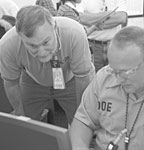

![]()
 Enforcement seen as ticket to improving Lab’s parking situation
Enforcement seen as ticket to improving Lab’s parking situation
